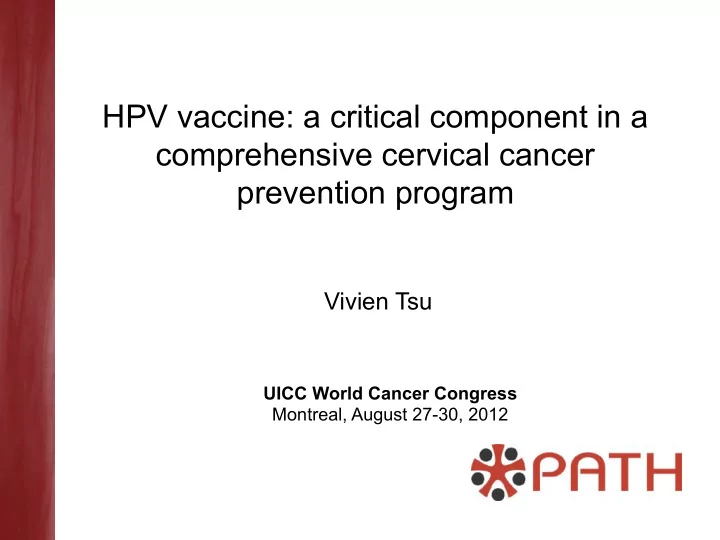

HPV vaccine: a critical component in a comprehensive cervical cancer prevention program Vivien Tsu UICC World Cancer Congress Montreal, August 27-30, 2012
Background on cervical cancer • Estimated to increase from Incidence highest in low and 529,828 cases in 2008 to middle income countries 776,032 in 2030* • Failure of cytology screening to have impact in low- or middle-income countries • New prevention opportunity in form of vaccines against primary causal agent— human papillomavirus *Globocan, 2008 (HPV)
Two vaccines available • Both highly effective • Both registered in >120 against HPV types 16 countries and 18—responsible for ~ 70% of cervical cancer* • Both pre-qualified by WHO (i.e. safe and effective for UN purchase) • Both very safe— no deaths , rare serious • Recommended by WHO adverse events (for for girls aged 9-13 women with other risk factors) * One also protects against non- oncogenic types, HPV 6 and 11
National and pilot introductions 43 countries – national 20 countries – pilot or demo
PATH HPV Vaccine Demonstration Projects Uganda Vietnam (districts) (provinces) Thanh Hoa • Nakasongola Peru (regions) India • Ibanda (states)
Vaccine delivery strategies • Schools All countries • Community health centers Vietnam, Peru, India (out-of-school girls) • Outreach programs Uganda Over 66,000 girls eligible
Overall, coverage was high – both initial acceptance and completion Coverage survey data, school-based delivery India (Yr1) Peru (Yr1) Uganda Vietnam (Yr2) (Yr2) At least 1 dose 82% 84% 96% 97% All 3 doses 79% 82% 89% 96% Completion 1 → 3 97% 98% 93% 99% • Little difference in coverage between strategies: greater variance in terms of cost per vaccinated child • Strong community mobilization efforts; careful training of health workers
Communication materials developed • Manuals • Leaflets • Posters • Fact book • Radio spots • Banners
Lessons learned: Factors for success 1. Secure visible government endorsement / participation. 2. Provide training for health workers, teachers, and others involved in program. 3. Engage communities through sensitization and mobilization, with strategic use of media. 4. Use pulsed schedules to facilitate community awareness and ease health worker burden. 5. Build educational messages on positive attitudes towards vaccines, prevention of cancer. 6. Have crisis communication plan in place. 7. Tailor delivery strategy. Schools can reach majority of eligible girls, with mop-up for those not in school (or absent on vaccination day).
Practical Experience Series from PATH • Lessons learned and resources for decision-making and vaccination program planning. – Planning – Formative research – Vaccine implementation – Evaluation – Screening www.rho.org/HPV-practical-experience.htm
Vaccine financing Price per Dose • Low income countries $0 $25 $60 $120 – GAVI approved, 2011 – Contingent on final price negotiated (<$5/dose) and country ability to deliver successfully 2006 07 08 09 2010 • Middle income – Price drop (~$15-30/dose) – PAHO Revolving Fund (~ $13/dose)
GAVI opportunity • 57 countries eligible for GAVI assistance • 2 HPV vaccine pathways approved – National introduction – Demonstration project • Demonstration project has 3 objectives 1. Learn by doing, on small scale first 2. Explore opportunities for integrating with other adolescent interventions 3. Strengthen or develop comprehensive national cervical cancer control strategy
Many resources now available • Online library at www.rho.org • Action planner
WHO tools for cervical cancer prevention and control http://www.who.int/nuvi/hpv/resources/en/index.html http://www.who.int/reproductivehealth/topics/cancers/index.html
Why a comprehensive prevention approach? • Vaccine not 100% effective – still need screening • Issue of generational equity – many women already infected, won’t benefit from vaccine • In long run, vaccine will ease burden on screening as there are fewer positives needing treatment • Synergies in raising awareness about cervical cancer prevention – both screening and vaccine >> demand • Engages broader range of stakeholders • Allows countries to start from where they are and build accordingly
Conclusions • Immunization is trusted, familiar, and less likely than other services to have inequities in coverage. • Many synergies for combining screening and HPV vaccination, although timetables for introduction and scale-up may differ. • Options for affordable screening and HPV vaccine now exist. • In the long term, a comprehensive approach offers the biggest payoff.
Thank you Vivien Tsu, PhD MPH Director, HPV Vaccines Project vtsu@path.org www.path.org/cervicalcancer
Recommend
More recommend